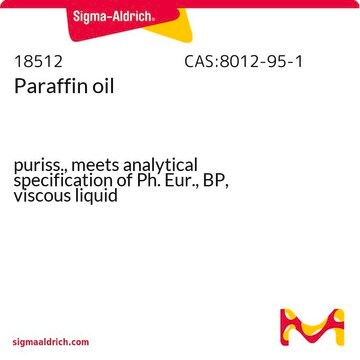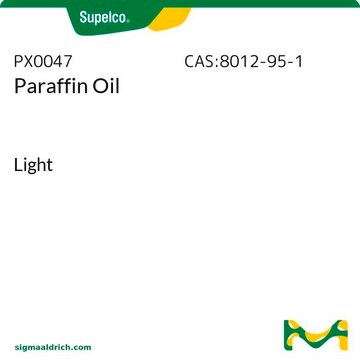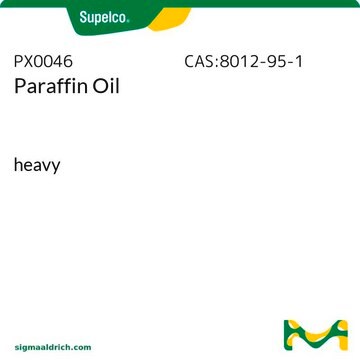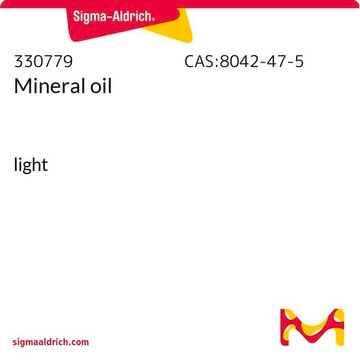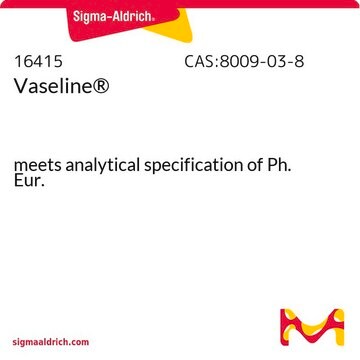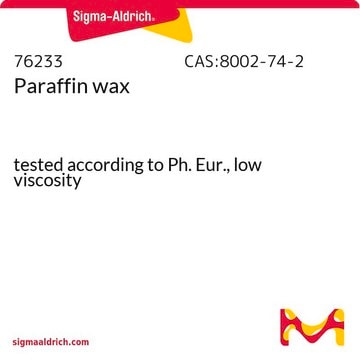76235
Paraffin oil
suitable for IR spectroscopy
Iniciar sesiónpara Ver la Fijación de precios por contrato y de la organización
About This Item
Productos recomendados
form
oil
Quality Level
technique(s)
IR spectroscopy: suitable
refractive index
n20/D 1.473
viscosity
100-145 mPa.s(20 °C)
bp
300 °C (lit.)
mp
-24 °C (lit.)
¿Está buscando productos similares? Visita Guía de comparación de productos
Categorías relacionadas
General description
Paraffin oil resists water. It is widely used as release agent, lubricant, defoamer and also as coating component.
Application
Paraffin oil has been used in preparation of tyrosinase-modified carbon paste electrode for detection of Catechol.
signalword
Danger
hcodes
Hazard Classifications
Asp. Tox. 1
Storage Class
10 - Combustible liquids
wgk_germany
WGK 2
flash_point_f
419.0 °F - closed cup
flash_point_c
215 °C - closed cup
ppe
Eyeshields, Gloves, type ABEK (EN14387) respirator filter
Choose from one of the most recent versions:
¿Ya tiene este producto?
Encuentre la documentación para los productos que ha comprado recientemente en la Biblioteca de documentos.
Los clientes también vieron
Rate-limiting steps of tyrosinase-modified electrodes for the detection of catechol.
Burestedt E
Analytical Chemistry, 68(9), 1605-1611 (1996)
Eryn Slankster et al.
Scientific reports, 10(1), 3119-3119 (2020-02-23)
Starvation enhances olfactory sensitivity that encourage animals to search for food. The molecular mechanisms that enable sensory neurons to remain flexible and adapt to a particular internal state remain poorly understood. Here, we study the roles of GABA and insulin
Jyothi C Abbar et al.
Bioelectrochemistry (Amsterdam, Netherlands), 83, 1-7 (2011-07-26)
The electrochemical oxidation of a hemorheologic drug, pentoxifylline was investigated at a multi-walled carbon nanotubes-paraffin oil paste electrode using cyclic and differential pulse voltammetry. The oxidation process was irreversible over the pH range studied and exhibited an adsorption-controlled behavior. All
Ozlem Yigit et al.
The Journal of emergency medicine, 42(4), 417-419 (2010-12-24)
Fire-eater's pneumonia is a chemical pneumonitis that can develop after accidental aspiration of liquid hydrocarbon-based fuel during a flame-blowing or a fire-eating performance. Typical findings of the patient are similar with any infectious pneumonia: chest pain, shortness of breath, cough
Maria Koliou et al.
European journal of pediatrics, 169(7), 833-838 (2009-12-18)
Information on childhood poisonings in Cyprus is limited. Our objective was to examine the epidemiology of poisonings among children in Cyprus. All children up to 15 years of age admitted for poisoning to the Archbishop Makarios Hospital in Nicosia, Cyprus
Nuestro equipo de científicos tiene experiencia en todas las áreas de investigación: Ciencias de la vida, Ciencia de los materiales, Síntesis química, Cromatografía, Analítica y muchas otras.
Póngase en contacto con el Servicio técnico